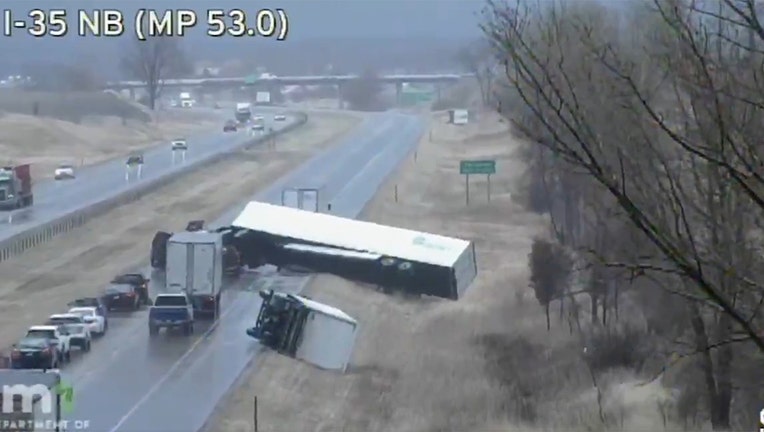MnDOT will use Wireless Emergency Alerts to inform drivers of major crashes, road closures

Multiple overturned semis on I-35W near Faribault have stalled traffic on April 12, 2022.
ST. PAUL, Minn. (FOX 9) - The Minnesota Department of Transportation will start using Wireless Emergency Alerts (WEAs) to share emergency information with motorists.
MnDOT will send out these alerts using the Integrated Public Alert & Warning System (IPAW), FEMA’s national system for local alerting, which is the same system that sends out Amber Alerts. WEAs allow important alerts to be sent directly to mobile devices without requiring any specific app or subscription service.
"The ability to send WEA messages through IPAWS is an important additional tool for MnDOT to provide real-time information to the traveling public," said Commissioner Nancy Daubenberger. "Road closures can occur suddenly, especially in cases of severe weather or major crashes on the highway system. With WEA messages, MnDOT will be able to send immediate mobile alerts to people in the vicinity of a highway closure or detour – helping minimize motorists on roadways during winter conditions and aiding law enforcement and emergency personnel in responding to incidents quickly."
Departments of Transportation in Pennsylvania, Georgia and Texas have used WEAs previously for road closure alerts, MnDOT said. Local sheriff’s offices have access to WEAs for public safety reasons as well.
MnDOT will use WEAs in greater Minnesota, where the agency doesn't have digital overhead signage like in the Twin Cities metro, MnDOT told FOX 9.
MnDOT will send these emergency alerts only when highway closures are expected to last more than four hours due to weather or major crashes or incidents. The alerts will only be sent for closures on state highways and interstates under MnDOT's purview and will send the alerts to all mobile devices within a one-mile radius, beginning 10 miles ahead of any closure location. The emergency could require a larger area for notifications depending on the situation, MnDOT said.
The alert will also include a link that will connect the public with information on the accident and its location.

